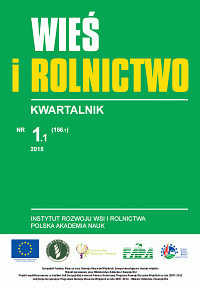Specyfika rolnictwa rodzinnego w Polsce: ciężar przeszłości i obecne uwarunkowania
The specificity of family farming in Poland: the weight of both past and present conditions
Author(s): Maria HalamskaSubject(s): Social Sciences
Published by: Instytut Rozwoju Wsi i Rolnictwa Polskiej Akademii Nauk
Keywords: Polish family farming; a specific evolution; agriculture dual holding professional; quasi-peasant farms; polskie rolnictwo rodzinne; specyficzna ewolucja; rolnictwo dualne; gospodarstwa profesjonalne; gospodarstwa quasi-chłopskie
Summary/Abstract: The author provides an analysis of family farming in Poland in the period 1990–2012 with special attention on the close links of ownership and the operation of the farm by family members. The weight of various factors are given close attention, including the historical context of the farm, current conditions and future intensions for the farm. The historical context acknowledges and stresses the importance of the late abolition of serfdom made by the partitioning powers, various agricultural reforms in the period 1919–1944, and the period between 1948–1989 – when family farming was incorporated into deficient centrally planned economy. This latter period saw family farms developing specific mechanisms of functioning, which can be seen two decades later. Analysis of the period 1990–2012 is based on the data of the Central Statistical Office, the present study and other published materials. The data series includes individual farms more than 1 ha, based on family labour. Separated are two sub-periods: the post-communist transformation period from the early 1990s and a period after 2002 to 2012. The latter almost coincides with the accession to the EU. In the first period the article outlines the process of creating duality in Polish agriculture. This describes a group of family farms where the household strongly reacted to the market and became larger and modernized (professional – 1/3 of the total) and small, extensive and producing mainly for own consumption (semi-subsistence – 2/3). In the second period the functioning and the transformation of households taking place under the CAP is examined. Modernisation is primarily seen on the Professional farm. Specific mechanisms can be seen that provide for the fairly stable functioning of semi-subsistence farms, independent of the market, with non-farm incomes and agricultural social security. These farms resisted collectivisation and stopped and hindered modernization in the communist period, and in this post-communist transformation now requires a doubly controlled modernization process. Przyjmując, że gospodarstwa rodzinne to rolnicze jednostki produkcyjne, w których własność i praca ściśle powiązane są z rodziną, autorka analizuje funkcjonowanie rolnictwa rodzinnego w Polsce w okresie 1990–2012. Zgodnie z założeniem, że o sposobie funkcjonowania gospodarstw decyduje ciężar przeszłości, zamiary na przyszłość oraz obecne uwarunkowania, sporo uwagi poświęca każdemu z tych czynników. Osadzając analizę w historycznym tle, podkreśla znaczenie późnego zniesienia pańszczyzny, dokonanego przez państwa zaborcze, meandrów reform rolnych w okresie 1919–1944 oraz nieodległego okresu 1948–1989, kiedy rolnictwo rodzinne wtopiło się w centralnie planowaną gospodarkę niedoboru. W tym ostatnim okresie gospodarstwa rodzinne wykształciły specyficzne mechanizmy funkcjonowania, które widoczne są do dzisiaj.
Journal: Wieś i Rolnictwo
- Issue Year: 166/2015
- Issue No: 1(1)
- Page Range: 107-129
- Page Count: 23
- Language: Polish

